Chapter 2: Rōma
Via Flāminia: read the story (p. 23)

fīlius dormit.
Celer in sepulcrō stat.
Celer est amīcus!
tū amīcum habēs!’
Giscō īnfantem tenet.
arcus est magnificus!’
tū imperātōrem vidēs?
Claudius.
Catia est Britannica.
tū cellam quaeris?
in Subūrā habet.
īnsula est optima.
dominus est Faustus.
First impressions (p. 26)
As Gisco and Catia approached Rome along the Via Flaminia, they passed the Field of Mars (Campus Martius) named after the god of war because it was originally where soldiers did military training. Later it was used as a recreational space, but over the years temples, monuments commemorating Roman victories, and other grand buildings were constructed there.
On the Field of Mars, Catia and Gisco would have seen monuments and gardens. One of the most impressive was the Altar of Peace (Āra Pācis), which had been built by the first emperor, Augustus. Next to this was a huge obelisk from Egypt, which acted as a sundial. Its shadow fell across the center of the marble altar on Augustus’ birthday.
They then passed through the Arch of Claudius which was built into the Aqua Virgo, one of the aqueducts which brought water into the city. In this area were the city’s largest public bathing complexes. One of these, the Baths of Nero, had been completed only two years before, in AD 62, and surpassed all others in size and grandeur. There were also theaters, temples, and Nero’s wooden amphitheater.
As they got closer, the Temple of Jupiter Optimus Maximus (Jupiter the Best and Greatest) on the Capitoline Hill would have loomed above them. Coming round the side of the Capitoline Hill, they would enter the heart of the city, the Roman Forum.

The obelisk now stands in the Piazza di Montecitorio in Rome.
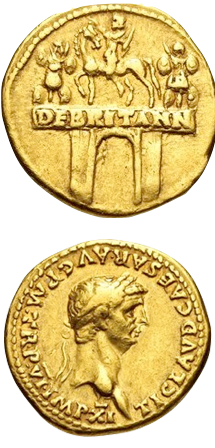
The Arch of Claudius was built to celebrate Emperor Claudius’ conquest of Britain in AD 43. The arch has not survived, but we can get an idea of what it looked like from this coin.
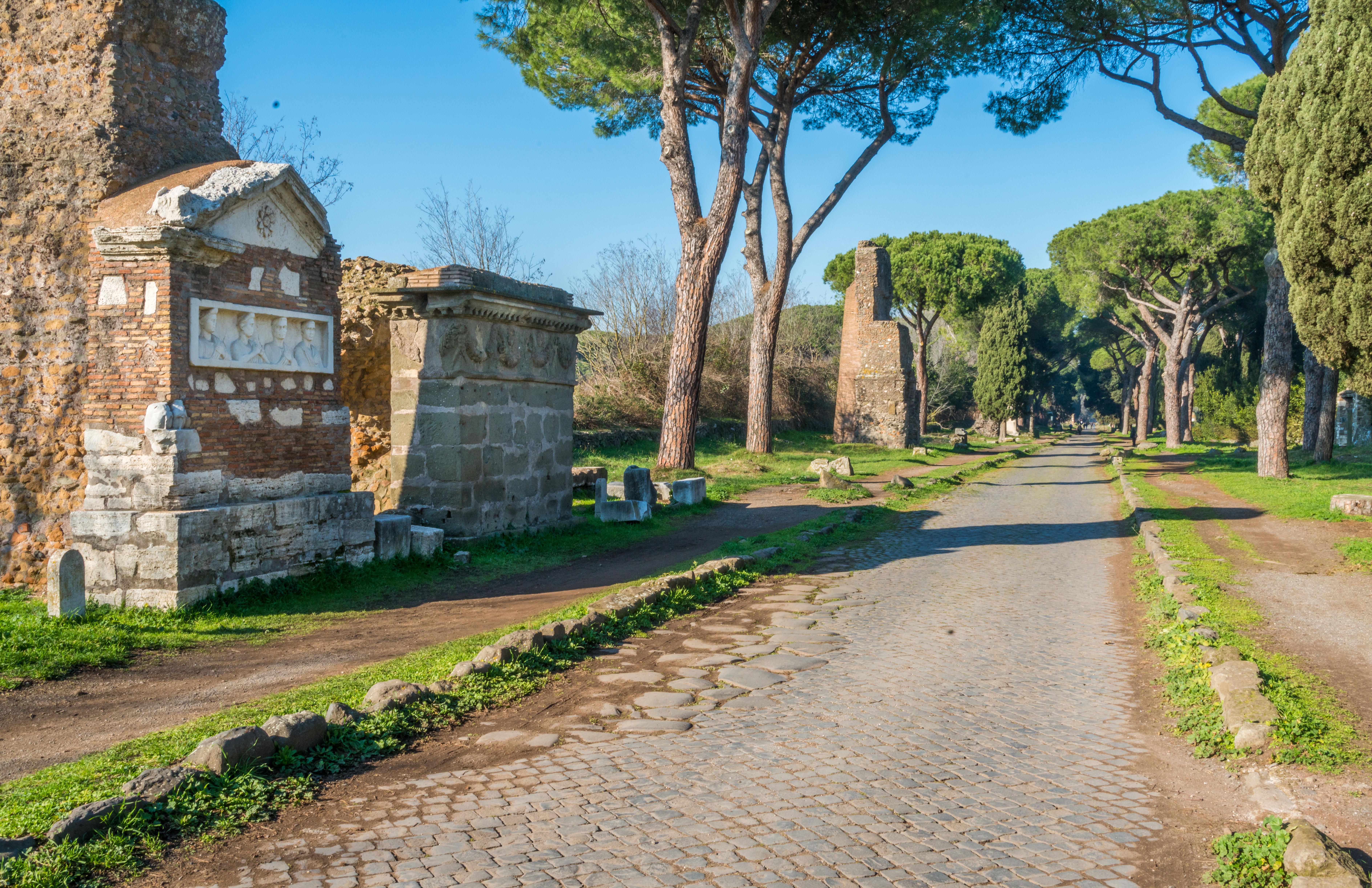
A Roman road (the Via Appia) lined with tombs, as it is now. Roman tombs were placed beside the roads outside the city boundary to separate the dead from the living.

The Ara Pacis was decorated with reliefs of processions, the imperial family, Roman gods, and important scenes from Rome’s legendary beginnings.

A Roman aqueduct. This one is in Segovia, in Spain.
QUESTION
The growth of Rome (p. 27)
By the time of our story, Rome was a large, bustling city and the center of a huge empire. It began as a tiny village on the River Tiber, and over centuries it grew into a mass of winding alleys punctuated with grand open spaces.
Location, location, location
The site of the earliest settlement is often said to have been the Palatine Hill, which provided a good defensive position. As Rome grew, it expanded into the surrounding hills. Famously, Rome was built on seven hills (in fact there are more): the Palatine, Capitoline, Esquiline, Aventine, Quirinal, Viminal, and Caelian. According to legend, the Palatine Hill was the home of Rome’s founder, Romulus. It later became the place where the emperors’ palaces were built. About 15 miles downriver was Rome’s harbor, Ostia. From there, ships brought goods upriver to the docks in Rome near Tiber Island.
Water and waste
The Great Drain (Cloāca Maxima) was constructed in about 600 BC to drain the marshy land that lay between the hills of Rome. It was originally an open- air canal, but the Romans later covered it over and constructed a sewage system to remove waste from the city into the Tiber. Aqueducts supplied the city with fresh water from springs in the surrounding countryside. This abundance of water was a key factor in maintaining the growing population of Rome, and soon came to symbolize power and wealth.
All roads lead to Rome?
By the first century AD Rome was at the center of a huge empire. A network of roads linked Rome to the cities of the Empire. Although large quantities of food and building materials were imported by sea, they were also transported via the well-maintained roads leading into Rome. These roads also enabled traders and laborers to come into the city each day from the surrounding countryside.
The Via Flaminia, one of the roads out of Rome to the north, was a route that was often taken to and from northern Gaul (France) and Britannia (Britain). The Via Appia went south to Brundisium on the south-east coast of Italy. From here travelers could sail on to Greece and the East. The Via Aurelia left Rome to the west, crossing the Tiber at the Aemilian bridge and following the coast through north-west Italy and into southern Gaul.
In my opinion, the three most impressive achievements which best display the greatness of Rome’s Empire are the aqueducts, paved roads, and sewers.
Dionysius of Halicarnassus

A model of the earliest settlement on the Palatine Hill.
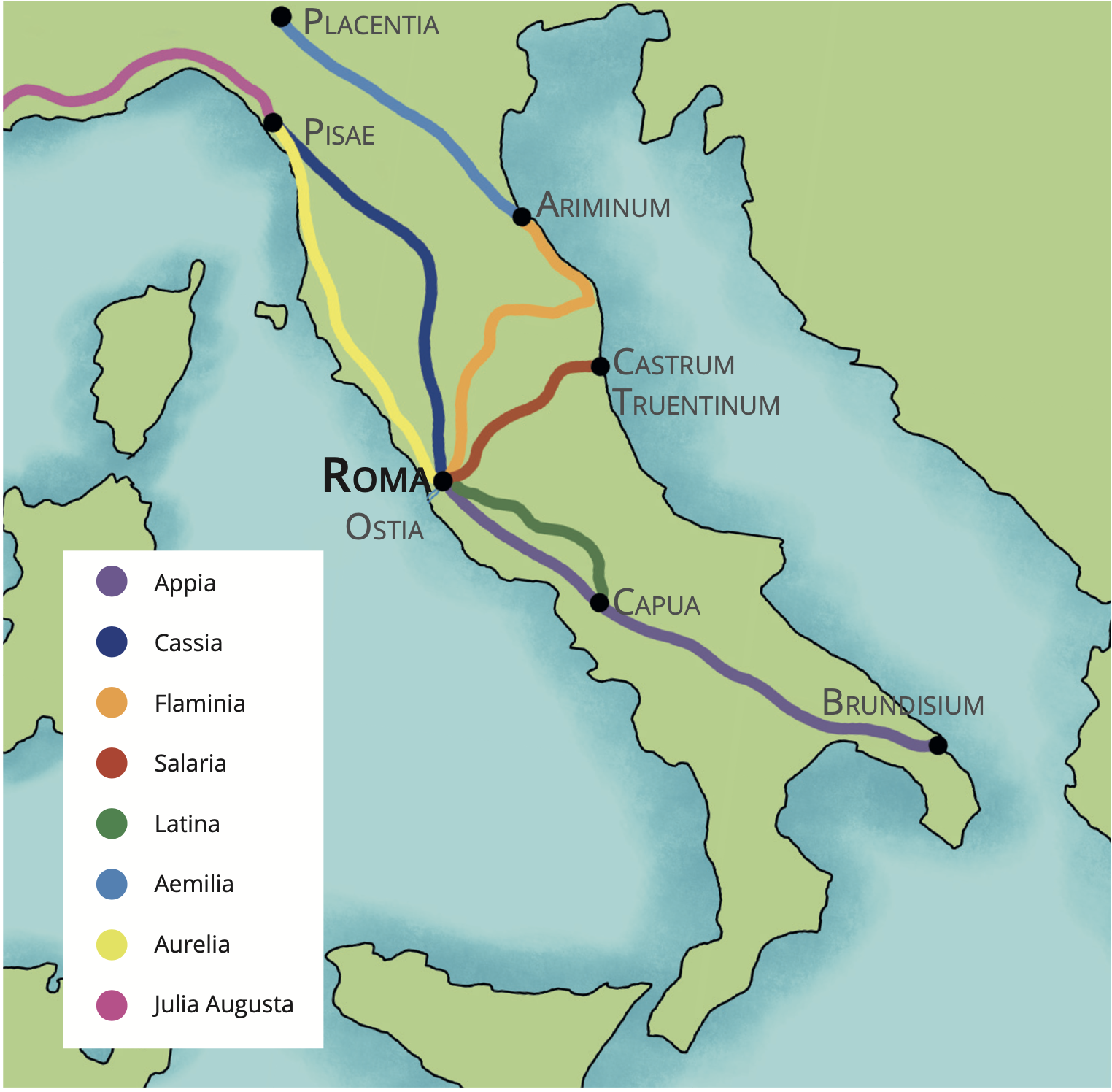
The main routes in and out of Rome.
Forum Boarium: read the story (p. 28)
Forum Boārium
clāmor est in popīnā. Rūfīna ē popīnā exit. Rūfīna Sabīnam vocat.
Rūfīna Sabīna, psittacus nōn adest!
Sabīna Quārtillam vocat. Quārtilla est ancilla. Sabīna cum Quārtillā
psittacum quaerit.
5Sabīna cum Quārtillā ad Forum Boārium venit. mercātor est in
forō. mercātor cibum habet. mercātor cibum vēndit.
mercātor ego multum cibum habeō! cibus meus est optimus!
mercātōrem intentē spectat Quārtilla. mercātor psittacum habet.
Quārtilla salvē, mercātor! tū psittacum habēs. tū psittacum vēndis?
10mercātor minimē, ego cibum vēndō. psittacus est meus.
psittacus tū es mendāx! tū es mendāx!
Sabīna certē tū es mendāx! tū es fūr!
Sabīna psittacum vocat. psittacus ad Sabīnam volitat. Quārtilla
rīdet. Sabīna psittacum tenet et ē forō currit.
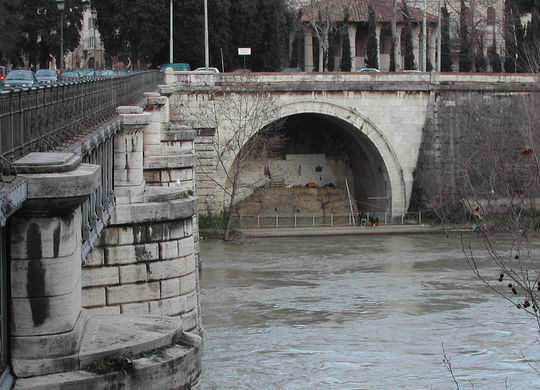
The Cloaca Maxima ran under the city from the north-east, through the Roman Forum, and into the River Tiber at the Forum Boarium. It drained excess water and removed waste and sewage. Other smaller sewers were connected to the Cloaca Maxima, serving public toilets, baths, and public buildings. Romans believed that the goddess Cloacina looked after the sewer.
What was a forum? (p. 29)
At the center of most Roman towns there was a forum, a rectangular open space surrounded by buildings and colonnades (covered walkways), similar to a square or piazza in a modern city. Originally a forum was a marketplace, with stalls selling food, clothes, pots and pans, jewelry, and all the other things people needed.
Owing to the size of the city, Rome had many fora spread across its different neighborhoods. People from all classes of society gathered in the fora to shop, conduct business such as banking, socialize, or visit temples and public buildings. Some fora were used mostly for public business and ceremonies. In these, lawyers argued cases in the law courts, candidates up for election made speeches, religious processions and ceremonies took place, and the emperor made appearances.
Rome also had fora which specialized in the sale of certain foods such as fish, pork, herbs and vegetables, and wine. One such market was the Forum Boārium, close to the docks at Tiber Island. Originally the cattle market (the Latin word for ‘cow' is bōs), it grew into an important commercial center. It was also a religious center, home to several temples.
As the population of the city grew, more fora were constructed, and several of these were built by emperors and powerful men. The general Julius Caesar built a new forum attached to the Roman Forum, and Emperor Augustus built another forum next to this a few decades later. The emperors Vespasian, Nerva, and Trajan built a further three new fora, creating a network of linked imperial fora in the heart of Rome. These fora, with their grand temples, monuments, and public buildings, were constructed at the emperor’s expense. They showed off to all who visited them the wealth, power, and generosity of the emperor.

Market square in the town of Mantua, Italy.
QUESTIONS
- What buildings and activities can you spot in this image?
- Compare market squares in towns today with the fora in Rome. To what extent do you think they fulfill the same functions?
Language note 1: Nominative and Accusative (p. 32)
-
Look at the following sentences:
Catia fīlium tenet. Giscō Catiam spectat.
Catia is holding her son. Gisco looks at Catia.equus in viā prōcēdit. Giscō equum dūcit.
The horse walks along the road. Gisco leads the horse.canis in sepulcrō stat. Giscō canem vocat.
The dog is standing on the tomb. Gisco calls his dog. -
In Latin, the endings of nouns change as their role in the sentence changes. If they are carrying out the action they have one ending, and if they are receiving the action of the verb they have a different ending. We call these different forms of nouns ‘cases’.
-
When a noun is carrying out the action, we say it is in the nominative case.
Rūfīna Sabīnam vocat. Rufina calls Sabina. Lūcīlius ērubēscit. Lucilius is blushing. mercātor cibum vēndit. The merchant is selling food. -
When a noun is receiving the action of the verb, we say it is in the accusative case.
Giscō cellam quaerit. Gisco is looking for a room. ego cibum vēndo. I’m selling food. Sabīna clāmōrem audit. Sabina hears a noise.
In Latin, the order of information is usually, but not always, nominative accusative verb:
| Catia fīlium tenet. |
| tū mendīcum vidēs. |
| Giscō canem vocat. |
| mercātōrem spectat Quārtilla. |
In the last example, how can you tell that it’s Quartilla who is watching the merchant, rather than the merchant watching Quartilla? Why might the writer have changed the usual order of information?
Forum Romanum: read the story (p. 31)
Forum Rōmānum
Faustus cum servō Forum Rōmānum intrat. servus est Lūcriō.
Forum Rōmānum est clāmōsum.
cūria est in Forō Rōmānō. prō cūriā Lūcriō senātōrem videt.
magnum servum habet senātor.
5Lūcriō ecce! senātor adest. tū magnam pecūniam dēbēs …
Faustus hercle!
Faustus cum Lūcriōne ad basilicam festīnat.
sed senātor Faustum prō basilicā videt.
senātor cum magnō servō ad basilicam ambulat.
10senātor salvē, negōtiātor! tū pecūniam meam habēs?
Faustus salvē, senātor! ego pēnsiōnem nōn habeō, sed …
senātor quid tū dīcis?
Lūcriō Faustus pecūniam semper trādit. Faustus nōn est fūr.
senātor signum dat. magnus servus Lūcriōnem verberat. Lūcriō cadit.
15Faustus pecūniam nōn habeō!
senātor tū pecūniam nōn habēs, sed fīliam habēs. ego ancillam quaerō.
cavē, negōtiātor. urbs est perīculōsa.
senātor ē forō exit. Faustus perterritus est.
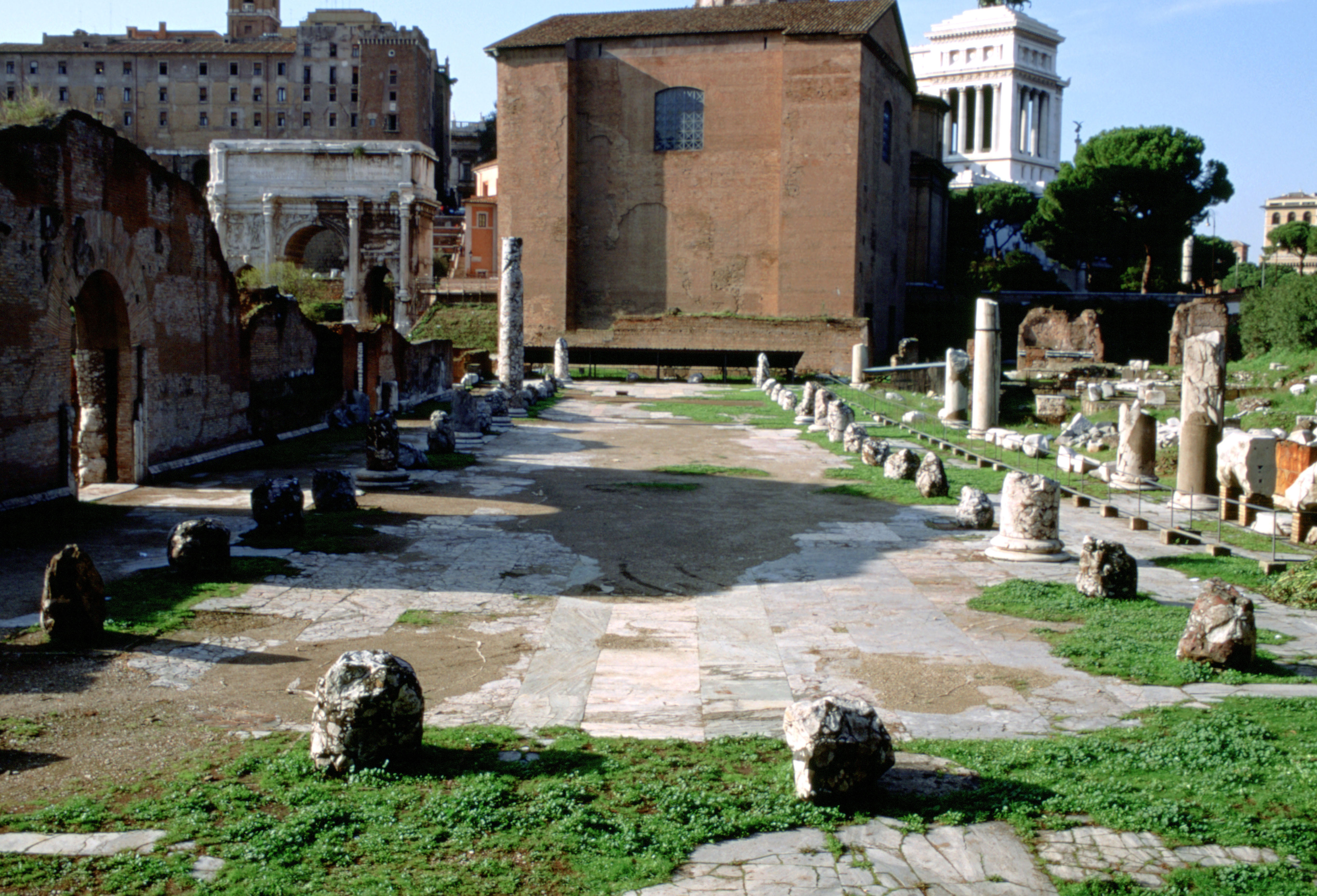
Photograph taken in the Roman Forum, showing the floor and column bases of the Basilica Aemilia in the foreground, and the side of the Senate House behind it. The Basilica Aemilia was a large hall where bankers and merchants conducted business.
The Forum Romanum (p. 32)
The Roman Forum (Forum Rōmānum) was an open square surrounded by magnificent buildings. It was the political, religious, and commercial center of Rome and the whole Empire. People of all classes, both inhabitants of the city and visitors, came to the Forum to socialize, engage in public and private business, worship, listen to speeches, watch processions, and just to gaze in amazement at the splendor of the public buildings. Rome was a city of contrasts, and one of the biggest contrasts was between the grandeur of its public spaces and the poverty of the streets and buildings where the majority of people lived and worked.
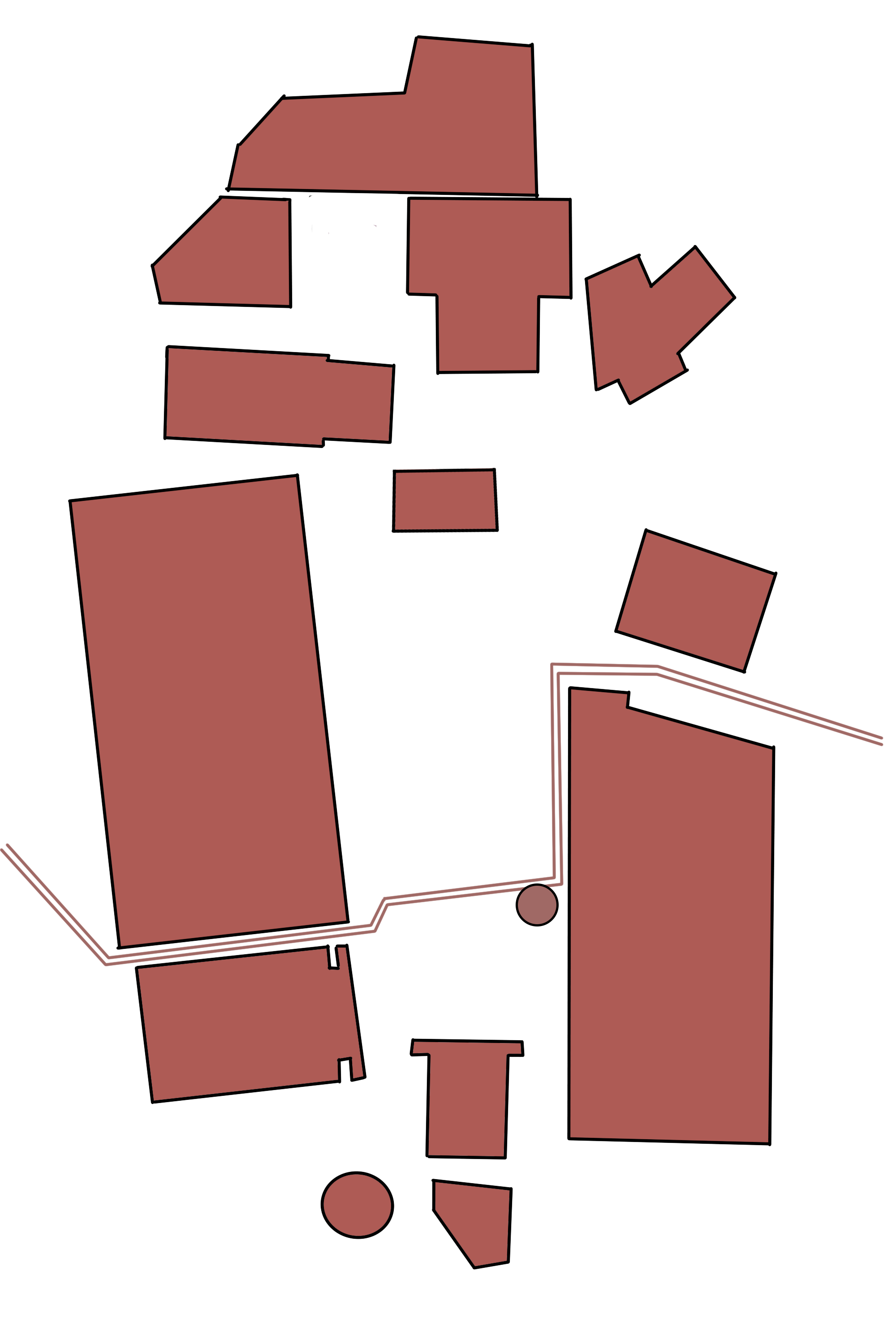 Temple of
Temple ofConcordia Tabularium Porticus
Deorum
Consentium Prison Temple of Saturn Basilica Julia Rostra Curia Basilica Aemilia Temple of Castor
and Pollux Temple of
Caesar Shrine of Vesta Regia
The Golden Milestone ( mīliārium aureum) was a tall column in the Forum Romanum which marked the starting point of the network of roads which radiated from Rome to all parts of Italy and the Empire. The distances to the cities of the Empire were inscribed on it in gilded bronze letters. It was erected by Emperor Augustus as a symbol that Rome was the center of the Empire. Its location in the Forum is not known.
I’ll show you where you’ll easily find every sort of man, ... whether it’s a wicked man or a virtuous one that you seek, honest or dishonest. If you want to find a perjurer, go to the Curia, for a liar and a boaster, go to the Shrine of Cloacina. At the old shops are those who lend or borrow money, and behind the Temple of Castor and Pollux are those you trust at your peril.
This extract from a comedy by Plautus gives an impression of the variety of people in the Forum Romanum.
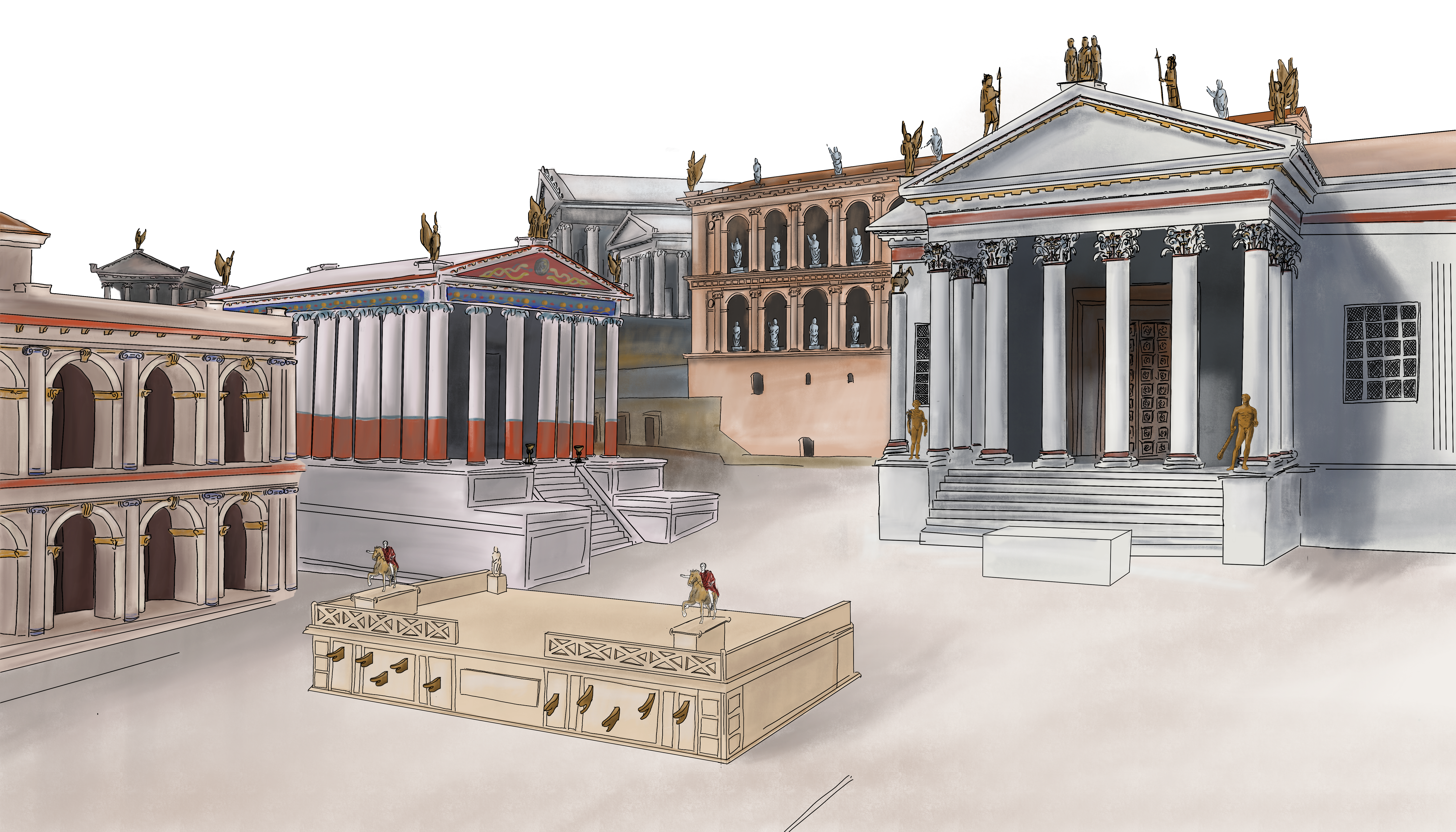
A reconstruction of the Forum Romanum, facing the Temple of Concordia with the Capitoline behind.
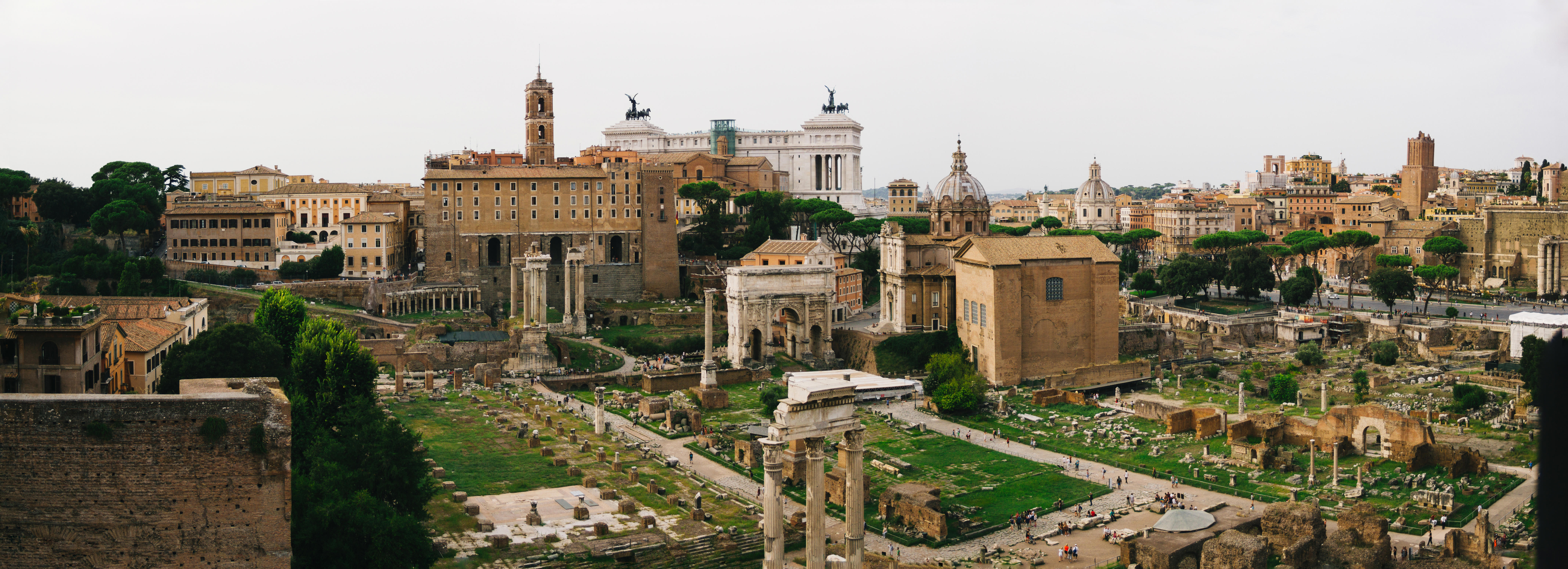
The Forum Romanum today, facing the remains of the Temple of Concordia.
Language note 2: Declensions (p. 34)
-
Some Latin nouns end -a in the nominative and -am in the accusative case:
Nominative: Rūfīna hōra turba īnsula Accusative: Rūfīnam hōram turbam īnsulam These are known as first declension nouns.
-
Some Latin nouns end -us in the nominative and -um in the accusative case:
Nominative: Faustus amīcus cibus servus Accusative: Faustum amīcum cibum servum This group of nouns is known as the second declension.
-
Other Latin nouns, which have a variety of endings in the nominative case and end -em in the accusative case, are third declension:
Nominative: Giscō īnfāns canis imperātor Accusative: Giscōnem īnfantem canem imperātōrem
Language practice 1 (p. 34)
-
Copy each sentence below, completing the ending of the noun. Then translate each sentence. Use the language note above for help with the noun endings.
- Giscō can... videt.
- Rūfīn... amīcum vocat.
- mercātor cib... vēndit.
- amīc... Faustum salūtat..
- ego īnsul... spectō.
- tū īnfan... tenēs.
cella: read the story (p. 35)
cella
Currāx per urbem festīnat. servus Giscōnem et Catiam ad Subūram dūcit.
servum Rūfīna videt.
Rūfīna salvē, Currāx!
Currāx veterānus cellam quaerit, domina. veterānus est Giscō.
5 Giscō uxōrem et fīlium habet. et canis est Celer.
fīlium tenet Catia. marītus Celerem mulcet. Rūfīna Giscōnem et
uxōrem salūtat. Rūfīna īnfantem laudat, sed canem ānxiē spectat.
Rūfīna vīnum et multum cibum portat. Catia cibum cōnsūmit.
Catia cibus est optimus, Rūfīna!
10Currāx Giscōnem ad cellam dūcit. Currāx cellam laudat.
Currāx cella est quiētissima. cella aspectum optimum habet.
cella est …
Giscō parva et obscūra!
subitō cadit tēgula et columba per rīmam volitat. Celer lātrat.
15magnus mūs per iānuam currit.
Giscō mūs in cellā habitat. cella nōn est optima, sed tū es
negōtiātor optimus, Currāx!
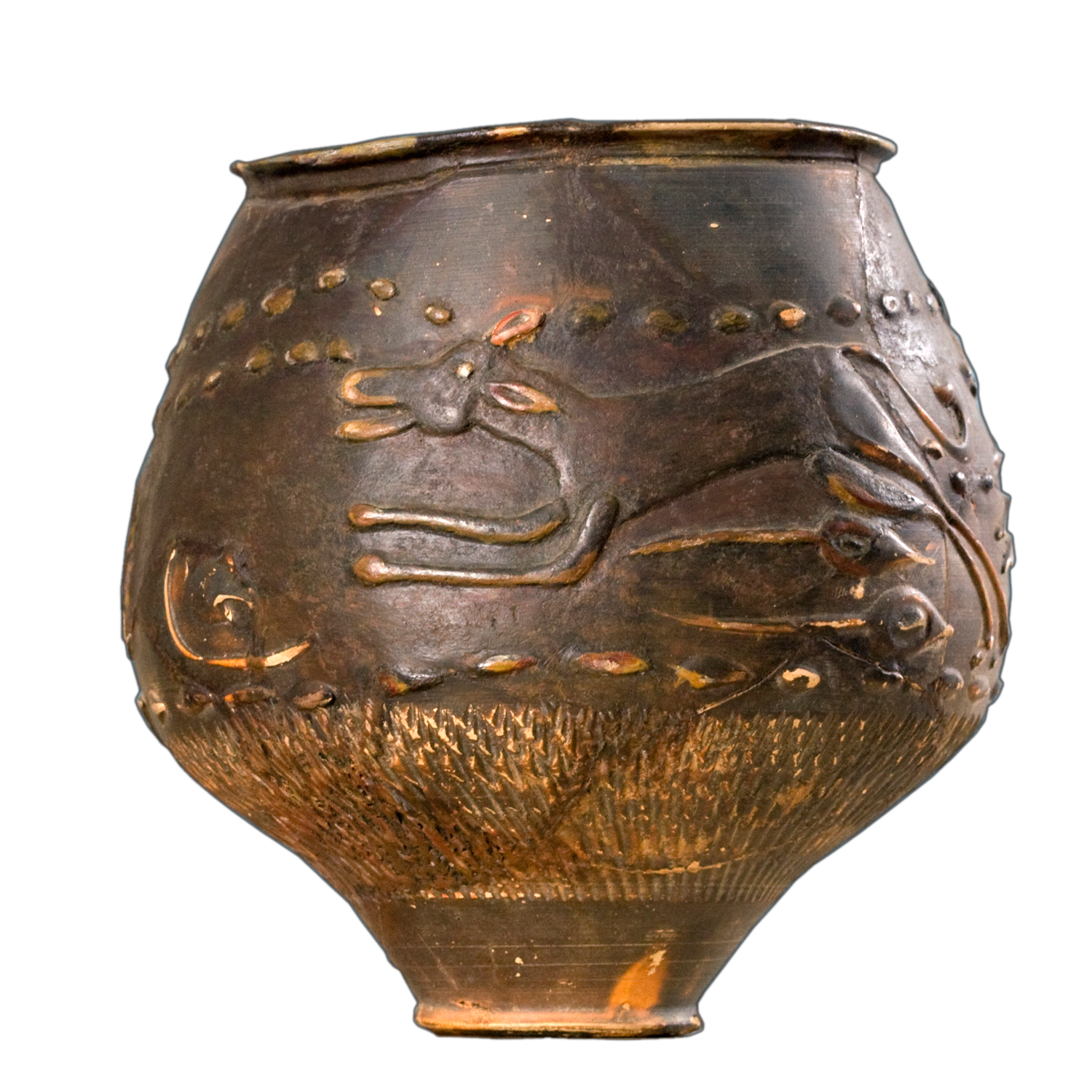
A cup showing a hunting dog.
Language note 3: Gender of nouns (p. 36)
-
All Latin nouns have a gender. They are masculine, feminine, or neuter.
-
Almost all first declension nouns are feminine, e.g. īnsula (apartment building) and turba (crowd).
-
Most second declension nouns are masculine, e.g. cibus (food) and equus (horse).
Some second declension nouns end -um in both the nominative and the accusative cases, e.g. vīnum (wine) and forum (marketplace). These nouns are neuter and we will study them further in Chapter 4.
-
Some third declension nouns are masculine, some are feminine, and some are neuter. For example, clāmor (noise) is masculine, nox (night) is feminine, and caput (head) is neuter.
-
When you look up a noun in the vocabulary, its gender is indicated by m., f., or n.
Language practice 2 (p. 36)
-
Using the dictionary on pages 283–296, write down the declension and gender of each noun.
For example: amita, 1st declension, feminine
- psittacus
- soror
- cloāca
- mercātor
- sepulcrum
- hōra
Language practice 3 (p. 37)
-
Select the correct form of the noun to complete each sentence, then translate.
- ego ... videō.(equus, equum)
- ... canem vocat.(servus, servum)
- tū ... habēs?(pecūnia, pecūniam)
- ... in popīnā sedet.(senex, senem)
- ... Faustus audit.(clāmor, clāmorem)
Language practice 4 (p. 37)
-
Select the correct form of the verb to complete each sentence, then translate.
- ego cibum ...(habet, habeō, habēs)
- Mānius in viā ...(sedēs, sedeō, sedet)
- tū in popīnā ...(labōrat, labōrās, labōrō)
- ego in Subūrā ...(habitō, habitat, habitās)
- Faustus īnsulam ...(intrō, intrās, intrat)


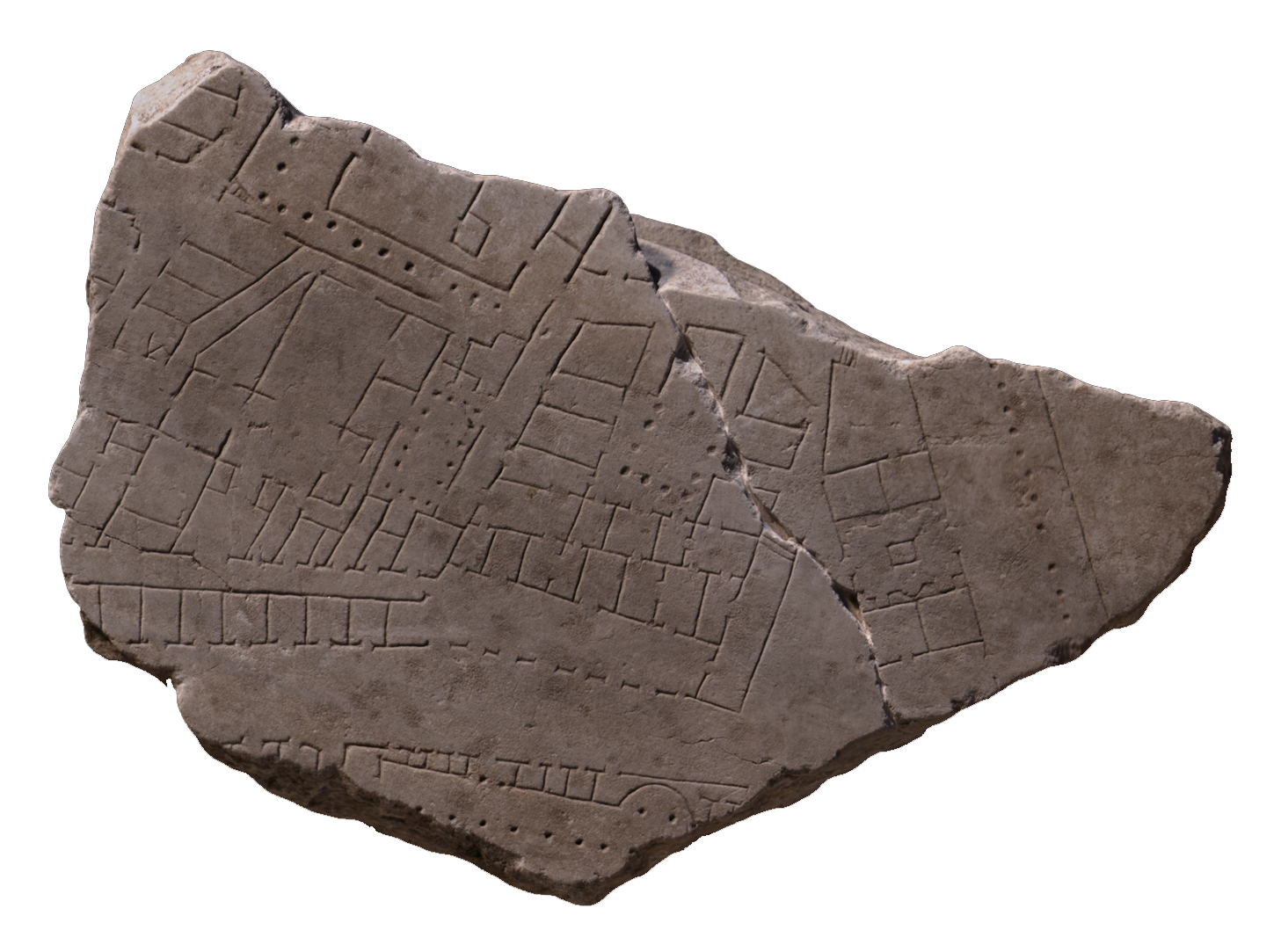
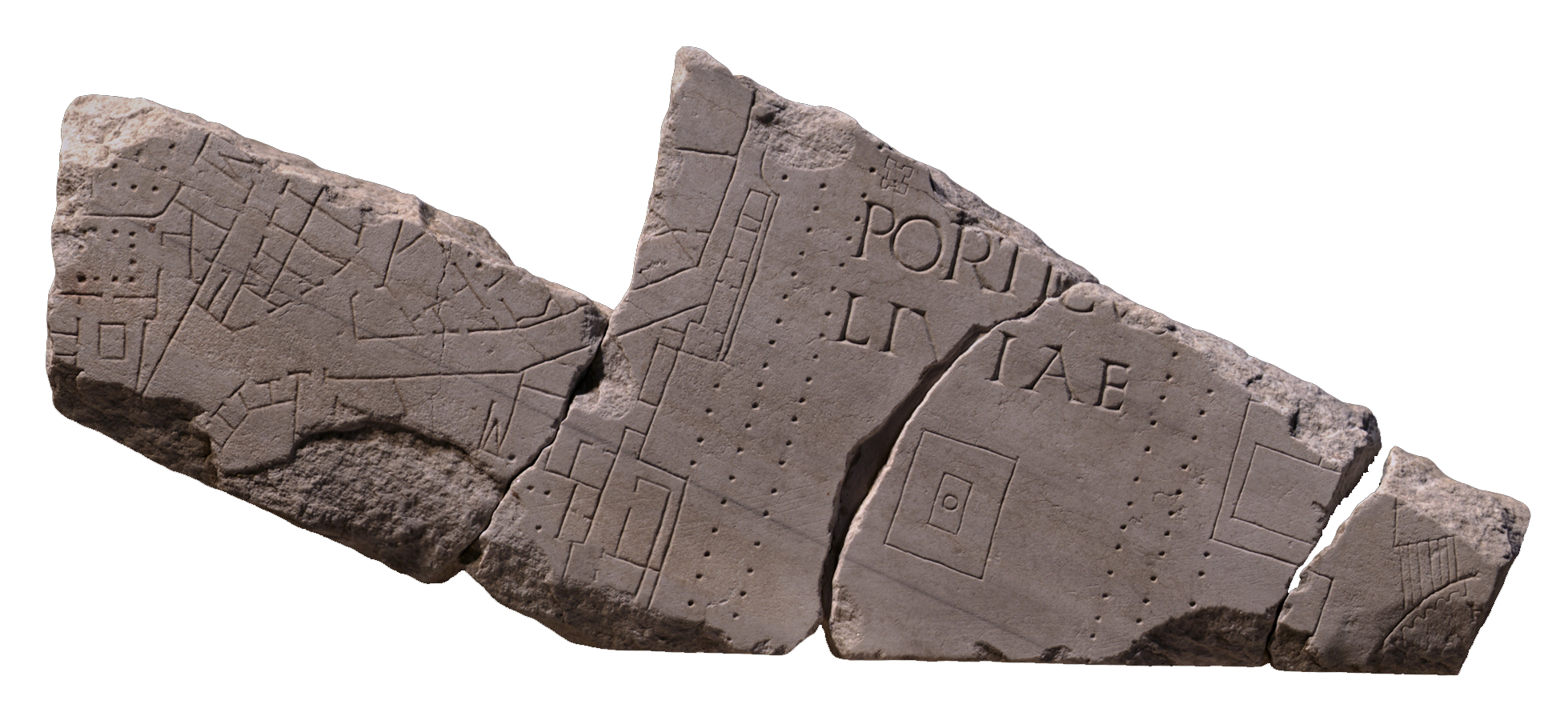
Fragments from the Fōrma Urbis Rōmae, the map of the city of Rome.
The Forma Urbis Romae was an enormous map, measuring about 60 x 43 ft and created around AD 211. Inscribed on stone was the plan of every architectural feature in the ancient city, from large public monuments to small shops. Only 10–15% of the original stone map survives, broken into 1,186 pieces.
Romulus and Remus (p. 38)
The story goes that, long before Rome existed, refugees from the Trojan War founded a hilltop town in Italy, which they called Alba Longa. Hundreds of years later the leader of the town, Numitor, was driven out by his brother. Numitor’s only child, Rhea Silvia, was forced to become a priestess and forbidden to have any children, so that Numitor would have no more descendants.
However, Rhea Silvia was visited by the god Mars (or so the story goes) and later gave birth to twin sons, Romulus and Remus. They were sent to be drowned, 12 miles away in the River Tiber. What then happened to those boys is the story of the foundation of Rome.
- Read or listen to the myth of Romulus and Remus – there are many versions!
SOURCE 1
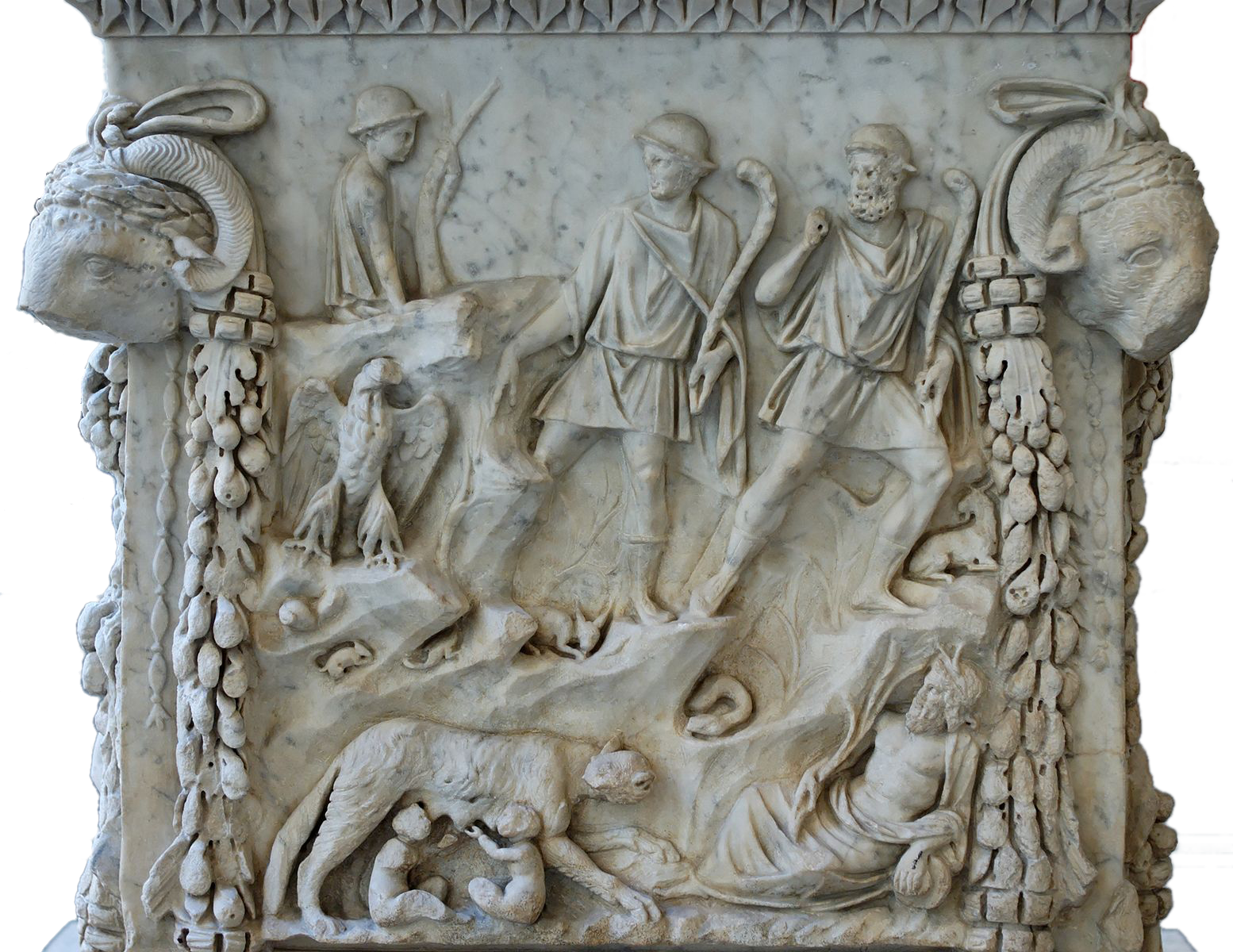
Altar to Mars and Venus.
The Wolf
Look at Source 1. What aspects of the myth can you see on the altar? The Romans celebrated the idea that Romulus and Remus were suckled by a wolf, in a cave now known as the Lupercal (in Latin, lupa means wolf). If you were writing a foundation story about a civilization, why might you have the founders suckled by a wolf, and in a cave? Later, the twins were brought up in the fields by a shepherd. How might that part of the story help poorer Romans relate to them? The shepherd’s name, by the way, was Faustulus, ‘Little Faustus’.
SOURCE 2
Remus jumped over Romulus’ new walls, mocking his brother. Romulus, in anger, killed his brother and added: ‘The same fate awaits anyone else who crosses my walls.’
Livy
Fratricide
Read Source 2. Romulus killed his brother, an act known as fratricide. Do you think it is a problem that Rome’s founder committed fratricide? Livy was writing at the time when Rome had recently endured many years of civil war (where Romans fought and killed other Romans), and already had a vast empire. How does Romulus’ murder of his brother fit into that context? What message do Romulus’ words send out to other nations?
Ancestors
The twins’ mother, Rhea Silvia, was descended from Aeneas, a Trojan prince who was himself the son of Venus, goddess of love. Their father was Mars, god of war. Why might the Romans want to create the idea that they were descended from these two deities? What characteristics would you expect from people who were the children of Venus and Mars?
SOURCE 3
All myths and legends have an element of truth.
Alfonsina Russo, Italian archaeologist.
Myth, legend, or history?
Look at Source 3. The story of Romulus and Remus is a myth. It isn’t true, but some people feel that parts of it may be. Archaeological evidence shows that there was a settlement on the Palatine Hill at the time of the mythological foundation of Rome (753 BC). Which aspects of the myth do you think may be based on fact? Which are fiction? Is it easy to tell? What is the difference between myth, legend, and history?
RESEARCH
Find out more about:
- Other foundation myths for Rome. Why might there be more than one story?
- The Trojans and the Trojan War. How does the story of Rome connect with the story of Troy?
- Foundation myths of other cultures. What do they say about how they see themselves?
